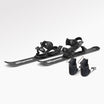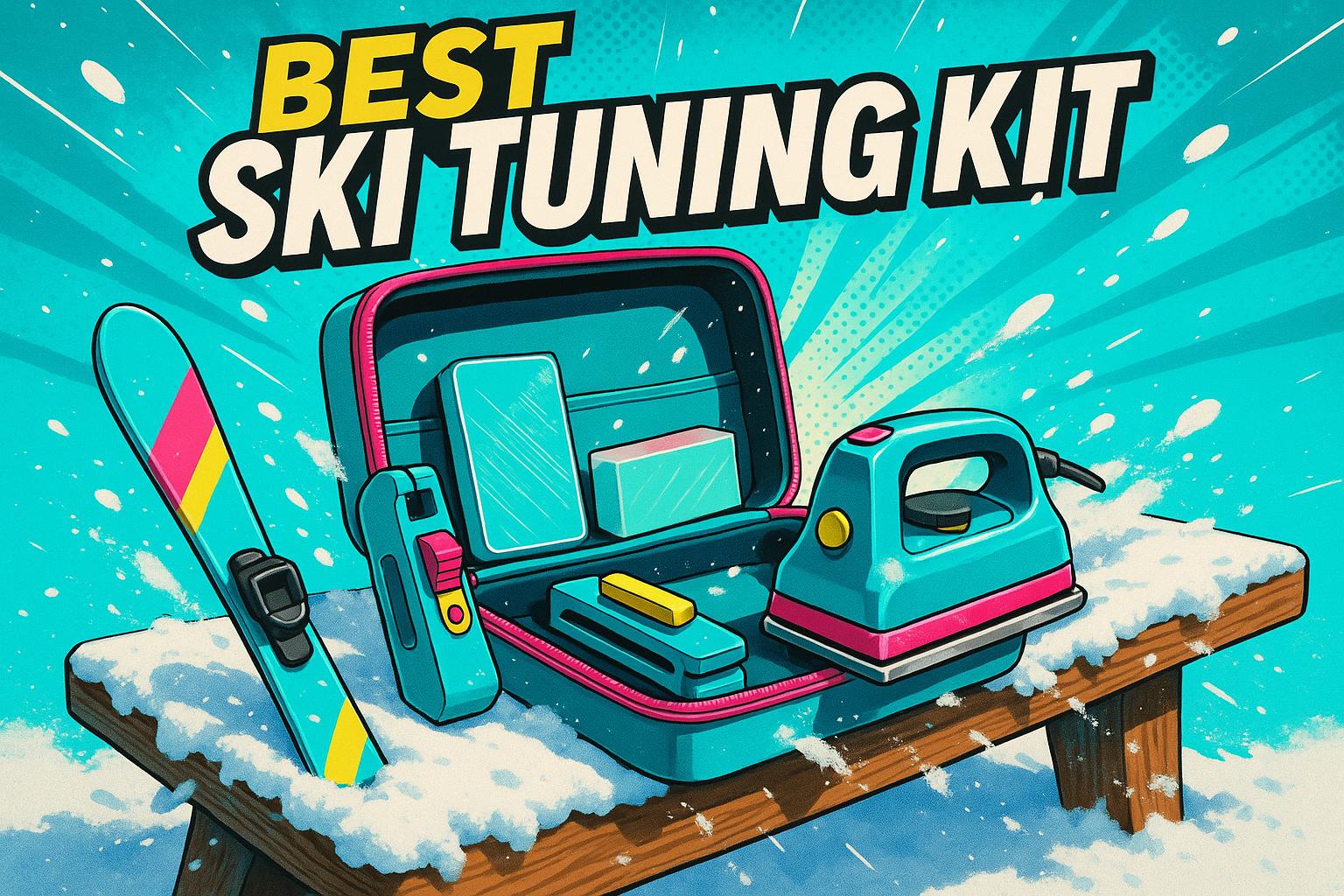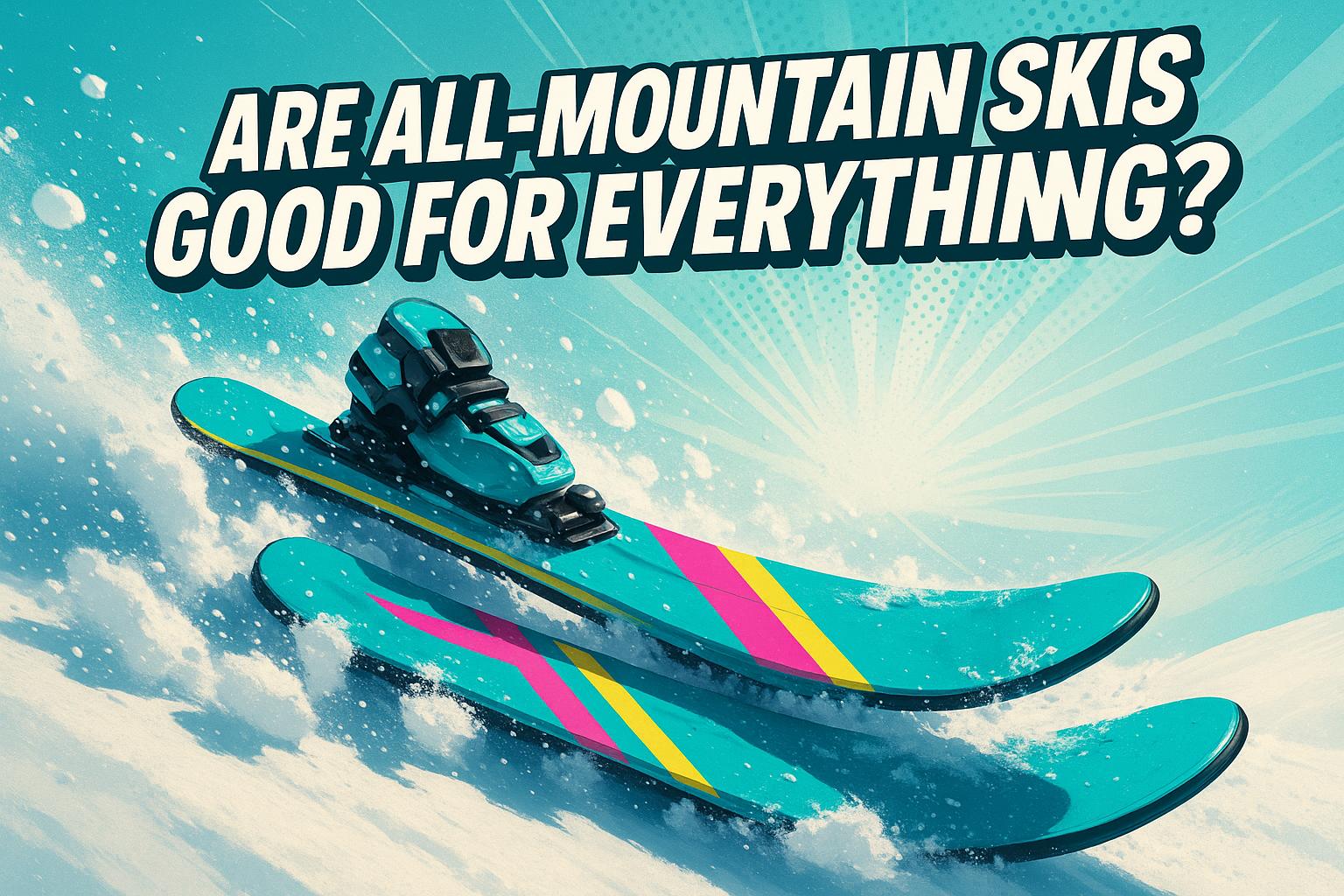スキーのエッジ研ぎは複雑である必要はありません。特にSnowfeetのギアを使っているならなおさらです。ポイントはこうです:鋭いエッジはより良いグリップ、滑らかなターン、そして安全なスキーを意味します。そしてSnowfeetのコンパクトなサイズなら、メンテナンスはとても簡単です。Mini Ski SkatesでもShort Skisでも、エッジを鋭く保つことが、氷や硬く締まった雪の上でコントロールを保つ鍵です。
Snowfeetのエッジを研ぐための簡単ステップ:
- 作業スペースの準備:頑丈なテーブルやベンチを使いましょう。大きな作業台は必要ありません。
- 清掃と点検:スキーを拭き、バリや損傷がないか確認します。
- 研ぐ:ダイヤモンドストーンや研ぎ工具を使ってエッジを滑らかにし、鋭くします。
- 仕上げ:クリーンなエッジのためにゴム石で仕上げます。
- 先端とテールのデチューン: 先端とテールを軽く丸めて滑らかなターンを実現しましょう。
なぜSnowfeetが簡単にするのか:
- コンパクトサイズ: 15~47インチで、長いスキーより扱いやすいです。
- 軽量: 重い持ち上げやかさばるセットアップは不要です。
- クイックメンテナンス: 短いエッジは研ぐ時間が短くて済みます。
プロのコツ:
- 氷上で滑る場合は3~5日ごとに研ぎましょう。
- 使用後は必ずSnowfeetを乾燥させて錆を防ぎましょう。
- デチューンを忘れないでください—鋭い先端はターンを難しくします。
適切なツール(ダイヤモンドストーン、グミ石、オプションのスキーバイス)があれば、研ぎは簡単で初心者にも優しいです。少しの手入れでSnowfeetをいつでもアクション-readyに保てます!
Snowfeet*スキーの研ぎ用ツールと用品 Snowfeet*

エッジ研ぎのための主要ツール
Snowfeet*のエッジを最高の状態に保つために大きな工具セットは必要ありません。必要なものはほんの少しの必需品だけで十分です。
- ダイヤモンドストーンは小さなバリや欠けを処理するために必須です。1個約17ドルで、初心者にも扱いやすく、やすりよりも優しいです。細かいダイヤモンドストーンはベースエッジのバリ取りや鋭さの回復に最適で、金属を削りすぎることなく仕上げられます。
- グミ石はエッジの研磨や微細なバリや軽い錆の除去に最適です。1個約15ドルで、CRATEX Brightboyグミ石は耐久性に優れており、定期的なメンテナンスに最適な選択肢です。
- スキーバイスはSnowfeet*を固定して作業を楽にしますが、必須ではありません。これらのバイスは80ドル以上することもありますが、Snowfeet*のコンパクトなサイズのおかげで、多くのユーザーは小さな作業台やテーブルに固定するだけで済ませています。
- 清潔なタオルとSnowfeet*エッジ研ぎ石(15.00ドル)を忘れずに。この便利なツールは、バリや錆、鈍い部分の素早い手直しに最適です。
これらのツールはメンテナンスをシンプルにするだけでなく、Snowfeet*製品がシンプルさを重視して設計されていることを示しています。
なぜ Snowfeet* 製品はメンテナンスが簡単なのか
Snowfeet*製品はスキーのメンテナンスの手間を省きます。専用ツールと組み合わせたデザインで、手入れが素早く簡単に行えます。
Snowfeet*のコンパクトなサイズは15インチから47インチまであり、キッチンテーブルや小さな作業台でエッジを研ぐことができます。大きなスペースや頑丈なバイスが必要な従来のスキーとは異なり、Snowfeet*製品は小さな場所にも快適に収まります。軽量設計なので扱いやすく、特に初心者にとっては助かります。
もう一つのメリットは?表面積が小さいため、従来のスキーに比べて研ぎ作業が速く終わります。これにより定期的なメンテナンスが促され、Snowfeet*を常に鋭く保ち、ゲレンデでのパフォーマンスを維持できます。
Snowfeet*スキーのエッジ研ぎステップバイステップガイド
作業スペースの準備
作業スペースの準備は、プロのようにSnowfeet*のエッジを研ぐための第一歩です。良いニュースは、Snowfeet*は従来のスキーよりずっとコンパクトなので、特別な設備は必要ありません。頑丈なキッチンテーブルや小さな作業台で十分です。安定して平らで明るい場所を選びましょう。
道具を揃えましょう:ダイヤモンドストーン、グミストーン、Snowfeet*エッジ研磨用ストーン、清潔なタオル。作業中にSnowfeet*が動かないようにバイスやクランプで固定します。ストーンに潤滑を施す場合は、小さな水のボウルを近くに置くと、ストーンの切れ味が良くなり詰まりを防げます。準備が整ったら、エッジの清掃と点検を始めましょう。
エッジの清掃と点検
研ぎに入る前に、エッジをきれいにして点検しましょう。まずは乾いた布でSnowfeet*の表面の水分や汚れを拭き取ります。頑固な汚れや塩分の残りがあれば、湿った布や必要に応じてスキーブラシを使いましょう。
次に、指でエッジをなぞって滑らかさをチェックします。簡単なテストとして、爪を軽くエッジにこすりつけてみてください。爪の削りかすが少し出れば、エッジが鋭い証拠です。ひび割れ、深い傷、変形などのダメージがないかよく見てください。小さな欠けやバリは簡単に直せますが、深刻なダメージは専門家の助けが必要かもしれません。人工雪は天然雪よりエッジに厳しいため、定期的なメンテナンスが特に重要です。すべて問題なければ、研ぎと研磨の準備完了です。
エッジの研ぎと研磨
まずはダイヤモンドストーンでバリや不規則な部分を取り除きます。このステップでファイリングがスムーズに進みます。
サイドエッジには、ファイルガイドを使って角度を一定に保ちます。一定の圧力をかけ、先端からテールまで長く均一なストロークで研ぎます。次に、Snowfeet*を裏返してベースエッジを研ぎます。ベースエッジ用のファイルガイドを使い、優しくコントロールされたストロークで適切な角度を維持しましょう。この角度がスキーの雪面グリップに重要な役割を果たします。
ファイリングの後は、再びダイヤモンドストーンを使ってエッジを研磨しましょう。これにより、残ったバリが取り除かれ、エッジが滑らかで鋭くなります。より良い結果を得るために、水または水とアルコールの混合液を使ってストーンの効率を保ちましょう。Snowfeet*のエッジ研磨用ストーンは、特にSnowfeet*のエッジが従来のスキーより短いため、素早い仕上げや最終研磨に最適です。これらのステップは時間がかかりませんが、大きな違いを生みます。
先端とテールのデチューン
最後のステップは先端とテールのデチューンで、滑らかでコントロールしやすいスキーを助けます。ゴム石を使い、わずかな角度で持ってエッジに沿って優しくこすり、先端とテールを丸めます。これにより接触点が柔らかくなり、ターン時の引っかかりを減らせます。
Snowfeet*では、短い設計のため、ターンの開始と終了において先端とテールの役割が大きいため、デチューンが特に重要です。作業が終わったら、最後にエッジを点検しましょう。メインの滑走面は鋭く保ちつつ、先端とテールはきれいに丸められていることを確認します。最後に金属の削りカスや石の残留物を拭き取り、Snowfeet*をゲレンデに出せる状態にしましょう。
Snowfeet* と従来のスキー&スノーボードの比較
Snowfeet*製品の利点
Snowfeet*製品は冬のスポーツギアに新しい視点をもたらし、従来のスキーやスノーボードと比べて明確な利点を提供します。特に際立つのはコンパクトなサイズです。従来のスキーは約5~6フィート、スノーボードは4~5フィートですが、Snowfeet*はわずか15インチから4フィート未満です。この違いだけで扱いやすさとメンテナンスのしやすさが大きく向上します。
もう一つの重要なポイントは素材です。木製コアの伝統的なスキースケートはフルサイズのスキーと同じく慎重なチューニングが必要です。一方、多くのSnowfeet*モデルは耐久性の高い高品質プラスチック製です。この設計は手入れを簡単にするだけでなく、初心者にとってエッジのメンテナンスの敷居を下げます。寛容な設計なので、正確な角度や複雑な調整を気にする必要はありません。
シャープニングに関しては、Snowfeet*製品は多用途に設計されています。整備されたゲレンデ、ハイキングトレイル、庭での遊びなど、どんな場面でもエッジの細かい調整を頻繁に必要としません。シャープニングにかける時間を減らし、雪を楽しむ時間を増やせます。
メンテナンスも簡単です。従来のスキーやスノーボードは、雪質や乗り方に合わせてエッジの角度を調整する必要がよくあります。Snowfeet*は短いエッジと寛容な設計により、初心者でも複雑な技術を習得せずに十分な結果が得られます。
もう一つの大きなメリット?コスト削減です。スキーやスノーボードのプロによるチューニングサービスは費用がかさみがちで、長い機材はメンテナンスにより多くの時間、労力、材料を必要とします。Snowfeet*製品は、その小さなサイズとシンプルな手入れのおかげで、自己メンテナンスでもプロに依頼しても、長期的にお金を節約できます。さらに、携帯性が高く収納も簡単。バックパックやクローゼット、元のパッケージにすっぽり収まります。6フィートのスキーでそんなことができますか?
比較表
| 特徴 | Snowfeet*製品 | 従来のスキー | 従来のスノーボード |
|---|---|---|---|
| エッジの長さ | 短め(15インチから4フィート未満) | 長さ(5~6フィート) | 長さ(4~5フィート) |
| 研ぎやすさ | 迅速で簡単 | 正確な調整が必要 | 長めのチューニングプロセスが必要 |
| 作業スペースの必要性 | キッチンテーブルでメンテナンス可能 | より広い作業エリアが必要 | 専用の作業スペースが必要 |
| メンテナンス頻度 | 許容設計のため頻度は少なめ | 定期的で正確なメンテナンス | 定期的なチューニングが必要 |
| 携帯性 | 非常に携帯性が高い(バックパックやクローゼットに収納可能) | スキーバッグやルーフラックが必要 | 収納バッグやケースが必要 |
| 初心者に優しい | 初心者にとって非常に簡単 | やや挑戦的 | やや挑戦的 |
| 地形の多様性 | ゲレンデ、トレイル、カジュアルな使用に対応 | 特定のコンディションに調整済み | 特定のコンディションに最適化 |
収納と持ち運びもSnowfeet*製品の強みです。伝統的なスキーやスノーボードは、かさばるバッグやルーフラックが必要で、調整したばかりのエッジを傷つけないよう慎重に扱う必要がありますが、Snowfeet*はどこにでも簡単に収まります。クローゼットでもバックパックでも、いつでも準備万端です。
sbb-itb-17ade95
スキーエッジの調整方法 - バリと錆の除去 || REI
メンテナンスのコツとよくあるミス
シーズンを通してSnowfeet*のパフォーマンスを最高に保つには、定期的なメンテナンスが鍵です。これに加え、よくあるミスを避けることで、ギアを最高の状態に保てます。
エッジを鋭く保つためのベストプラクティス
Snowfeet*の鋭いエッジを保つのは簡単な日課で、大きな効果があります。Denver Sports LabのLeif Sunde氏が説明しています:
"エッジは毎日のライドごとにダイヤモンドファイルでメンテナンスすべきで、まるで包丁を研ぐような感覚です。"
これは特にSnowfeet*に当てはまります。短いエッジのおかげで、伝統的なスキーに比べて素早いメンテナンスが可能です。
ライド後はエッジの摩耗やダメージをチェックしましょう。Snowfeet*のコンパクトなサイズなら、ガレージやキッチンでも簡単に点検できます。
使用後は必ずSnowfeet*を乾燥させることも重要です。耐湿性の素材が使われていることが多いですが、金属のエッジは錆びから守る必要があります。簡単に拭き取り、乾燥した場所に保管すれば十分です。伝統的なスキーのような専用の乾燥ラックは不要です。
道具はシンプルに。中目か細目のダイヤモンドファイルとSnowfeet*を固定するクランプがあれば十分です。研ぎの頻度は乗り方やコンディションによります。整備されたゲレンデでの週末ライドなら、週に一度の軽いメンテナンスでOKです。しかし、氷や岩場での厳しい日を過ごしたら、すぐにダメージをケアしましょう。
Top 1%のコメント投稿者であるgetdownheavyさんが賢く指摘しているように:
"最小限の自宅メンテナンスが、シーズンを通して何もしないよりもパフォーマンスを大幅に向上させます。"
Snowfeet*なら、少しの手間で大きな効果が得られます。定期的なケアがあれば、後で大掛かりな研ぎ直しは不要です。
よくあるミスとその回避方法
最善の意図があっても、ミスは起こり得ます。ここではよくある落とし穴とその回避方法をご紹介します。
- 過度のファイリング:従来のスキーと違い、Snowfeet*はエッジが短いため、1回1回のストロークが重要です。重いファイリングではなく、軽く一定のパスで行い、やりすぎを避けましょう。
- バリ取りを省略すること:ファイリング後は必ずグミストーンを使ってください。残ったバリはエッジを鋭く感じさせますが、パフォーマンスを悪化させます。
- 先端と尾部のデチューンを怠ること:先端と尾部が鋭すぎると、特に初心者はSnowfeet*が引っかかる感じがします。スムーズな滑りのために、各エッジの最初と最後の1インチをグミストーンで鈍らせましょう。
- 間違った角度での作業:モデルごとの推奨エッジ角度を必ず確認し、それを守ってください。一定で軽いストロークが最適です。
- 点検を無視すること:小さな傷でも放置すると大きな問題になります。衝撃を受けた後は必ずエッジを点検し、損傷があればすぐに対処しましょう。
- 不適切な固定:作業中は必ず安定した面にクランプでSnowfeet*を固定してください。手で持つとミスや怪我の原因になります。
- 急いで作業すること:時間をかけてください。一定で計画的なストロークの方が、急いでミスをするよりずっと良いです。
結論:Snowfeet*スキーのシャープニングは簡単です
Snowfeet*スキーのお手入れはとても簡単です。コンパクトなデザインのおかげで、従来のスキーに比べて最高の状態を保つのがずっと楽です。
フルサイズのスキーとは異なり、Snowfeet*は表面積が小さいためメンテナンスが簡単です。Snowfeetチームの言葉を借りれば:
「短い長さが初心者にぴったりです」。
このデザインはシャープニングのスピードアップだけでなく、扱いやすさも向上させます。さらにコンパクトなサイズなので、特別な機材なしでどんな家庭の作業スペースでも簡単に作業できます。
シャープニングの手順を簡単にまとめると次の通りです:
- Snowfeet*をしっかり固定してください。
- エッジをきれいにして点検しましょう。
- ダイヤモンドファイルを使って軽く一定のストロークで磨きます。
- 仕上げにシャープニングストーンでバリを滑らかにしましょう。
鋭いエッジがあればゲレンデでのコントロールが向上し、調整作業も従来のスキーに比べて速く簡単になります。
Snowfeet*が際立っているのは、その多用途性と初心者に優しい点です。従来のスキーは特定の地形向けに設計されることが多いですが、Snowfeet*はあらゆるコンディションで輝きます。さらに寛容なので、初心者はギアのメンテナンスに悩むことなく楽しむことに集中できます。
長持ちするパフォーマンスのために、いくつかの簡単なお手入れのコツを守りましょう:使用後は必ずSnowfeet*を乾かし、エッジに油をさっと塗って錆を防ぎます。38cmのMini Ski Skatesでも120cmのShort Skisでも、この簡単なメンテナンスでいつでも準備万端。そうすれば、メンテナンスの心配を減らして、ゲレンデでの時間をもっと楽しめます。
よくある質問
Snowfeetの研ぎは従来のスキーの研ぎとどう違うのですか?
スキーブレード、スキースケート、ショートスキーなどのSnowfeet製品の研ぎは、従来のスキーに比べてとても簡単です。コンパクトなサイズと短いエッジのおかげで、少ない労力で正確な仕上がりが得られます。さらに、スマートな設計により、研ぎ初心者でも滑走性能を向上させられます。
専用の工具や多くの時間が必要な通常のスキーとは異なり、Snowfeet製品はシンプルなエッジ研ぎツールで研げます。つまり、自宅で簡単にメンテナンスでき、コストも抑えられます。そしてエッジが鋭くなれば、よりスムーズなターン、優れたグリップ、そして斜面での楽しさが格段にアップします!
最高のパフォーマンスを得るために、Snowfeetのエッジはどのくらいの頻度で研ぐべきですか?
Snowfeetを最高の状態に保つために、3~5日使用ごと、または少なくともシーズンに1回エッジを研ぐ習慣をつけましょう。この簡単なメンテナンスで、より良いコントロール、スムーズなターン、安全なライドを楽しめます。特に氷結や硬い雪面を攻めるときに効果的です。
コンパクトなデザインと鋭いエッジのおかげで、Snowfeetは従来のスキーやスノーボードに比べて独自の優位性(言葉遊びです!)を持っています。しかし、その性能向上には少しの責任も伴います。定期的な研ぎは反応性を保つだけでなく、寿命を延ばし、毎回のライドを楽しくスムーズにします。
Snowfeetのスキーエッジをダイヤモンドストーンで研ぐとき、どんなミスを避けるべきですか?
Snowfeetのエッジをダイヤモンドストーンで研ぐ際に避けたいミスがいくつかあります。これらを守ることで、ギアの不必要なダメージを防ぎ、滑走時のパフォーマンスを鋭く保てます:
- 強く押しすぎる:強すぎる圧力はエッジを傷めたり、ムラのある仕上がりになります。軽く一定の力加減が最適です。
- 鈍いまたは汚れたダイヤモンドストーンを使う:道具が摩耗していたりゴミが付いていると、うまく研げず、エッジを傷つけることもあります。清潔に保ち、良好な状態を維持しましょう。
- 角度を間違える:間違った角度で研ぐとエッジが弱くなったり、性能に影響が出たりします。ギアに推奨されている角度を守りましょう。
- やりすぎ:素材を削りすぎるとSnowfeetに良くありません。寿命が短くなり、強度が損なわれる可能性があります。
時間をかけて、正しい技術を使い、Snowfeetを丁寧に扱いましょう。そうすれば、滑るたびによりスムーズなコントロールと安全なライドを楽しめます。


































コメントを残す
このサイトはhCaptchaによって保護されており、hCaptchaプライバシーポリシーおよび利用規約が適用されます。